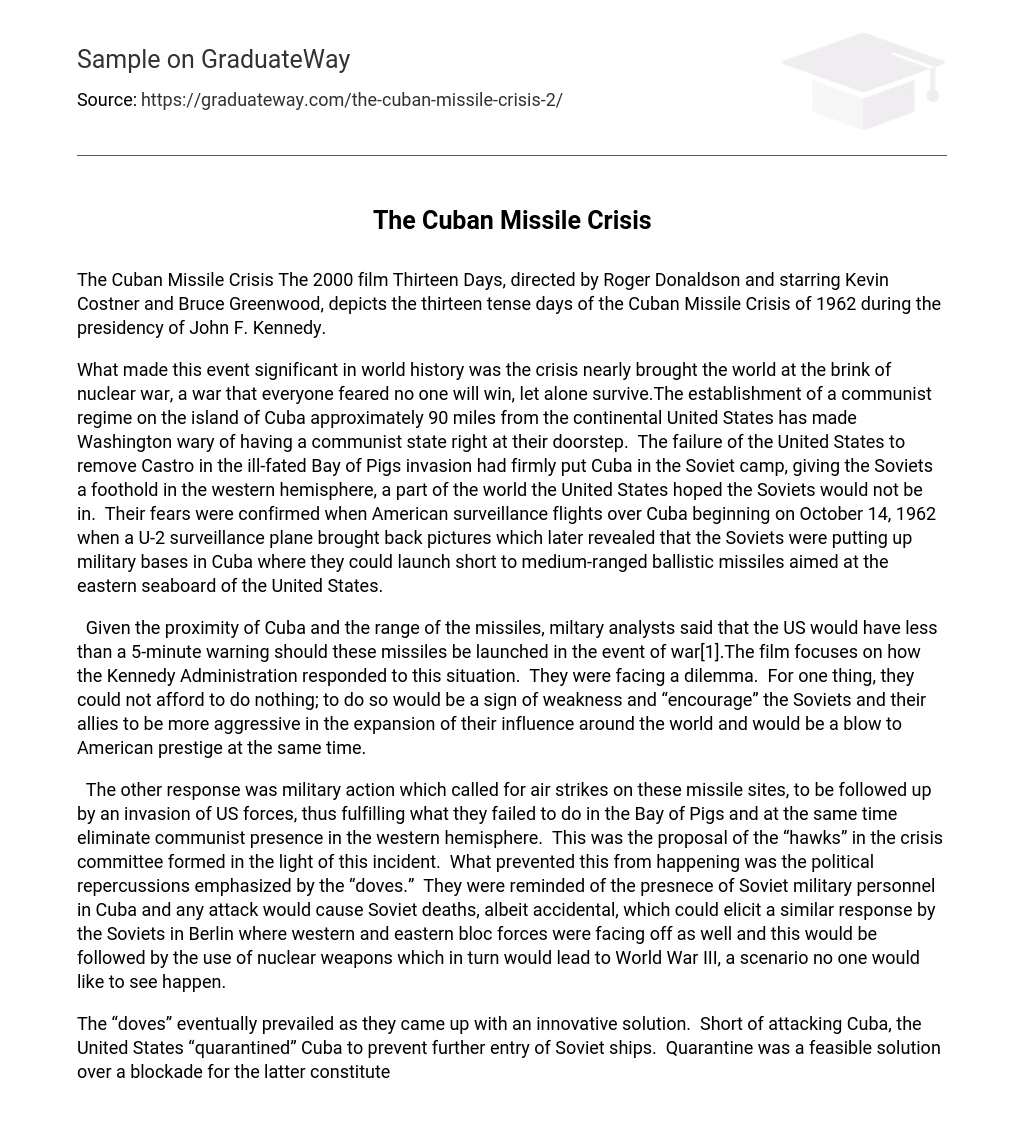The Cuban Missile Crisis The 2000 film Thirteen Days, directed by Roger Donaldson and starring Kevin Costner and Bruce Greenwood, depicts the thirteen tense days of the Cuban Missile Crisis of 1962 during the presidency of John F. Kennedy.
What made this event significant in world history was the crisis nearly brought the world at the brink of nuclear war, a war that everyone feared no one will win, let alone survive.The establishment of a communist regime on the island of Cuba approximately 90 miles from the continental United States has made Washington wary of having a communist state right at their doorstep. The failure of the United States to remove Castro in the ill-fated Bay of Pigs invasion had firmly put Cuba in the Soviet camp, giving the Soviets a foothold in the western hemisphere, a part of the world the United States hoped the Soviets would not be in. Their fears were confirmed when American surveillance flights over Cuba beginning on October 14, 1962 when a U-2 surveillance plane brought back pictures which later revealed that the Soviets were putting up military bases in Cuba where they could launch short to medium-ranged ballistic missiles aimed at the eastern seaboard of the United States.
Given the proximity of Cuba and the range of the missiles, miltary analysts said that the US would have less than a 5-minute warning should these missiles be launched in the event of war[1].The film focuses on how the Kennedy Administration responded to this situation. They were facing a dilemma. For one thing, they could not afford to do nothing; to do so would be a sign of weakness and “encourage” the Soviets and their allies to be more aggressive in the expansion of their influence around the world and would be a blow to American prestige at the same time.
The other response was military action which called for air strikes on these missile sites, to be followed up by an invasion of US forces, thus fulfilling what they failed to do in the Bay of Pigs and at the same time eliminate communist presence in the western hemisphere. This was the proposal of the “hawks” in the crisis committee formed in the light of this incident. What prevented this from happening was the political repercussions emphasized by the “doves.” They were reminded of the presnece of Soviet military personnel in Cuba and any attack would cause Soviet deaths, albeit accidental, which could elicit a similar response by the Soviets in Berlin where western and eastern bloc forces were facing off as well and this would be followed by the use of nuclear weapons which in turn would lead to World War III, a scenario no one would like to see happen.
The “doves” eventually prevailed as they came up with an innovative solution. Short of attacking Cuba, the United States “quarantined” Cuba to prevent further entry of Soviet ships. Quarantine was a feasible solution over a blockade for the latter constituted an act of war. While this was happening, the US waged a 2-front “blitz” with an overt denunciaiton of the Soviet Union at the United Nations Security Council while conducting secret informal back-channel negotiations between the Americans and Soviets through emissaries as both sides could not afford to be seen talking to each other in a conciliatory tone at this point in time.
It was during these negotiations that a compromise was reached. The Soviets agreed to pull out of Cuba with an assurance from the US that they will pull out their own missiles based in Turkey and not invade Cuba though they will continue to keep their naval base at Guantanamo on Cuban soil much to the consternation of Castro who was hoping to get Guantanamo back to complete his victory in the Cuban Revolution and affirm his stature among his people.The film revealed an inner conflict in the Kennedy administration, as shown by the “hawks” and “doves.” If one were to follow the film, the “hawks” were clearly upset of being denied a chance to exercise American military might over an enemy and even said that the Kennedys’ liberal ways would bring the country down[2].
It can be inferred here that this would be the proverbial tip of the iceberg which would lead to a subsequent chain of events, culminating in Kennedy’s assassination in 1963 should one subscribe to the conspiracy theory that Kennedy was not assassinated by Lee Harvey Oswald alone but that is another story that could be best discussed along with the viewing of Oliver Stone’s JFK.In conclusion, Thirteen Days is a very insightful film that would complement printed references about this crisis though the only difference here is that according to survivng members of Kennedy’s administration, Kennedy’s political adviser, Kenny O’Donnell (played by Kevin Costner) did not really play an active role in the crisis, contrary to what the film depicted. Nonetheless, it is still factual enough to give life to what history books and other references say about these thirteen tense days of 1962. Bibliography Costner, Kevin, Greenwood, Bruce.
Thirteen Days. Produced by Kevin Costner, et.al., Directed by Roger Donaldson.
145 mins. New Line Cinema, 2000. Film. [1] Kevin Costner, et.
al., Prods. Roger Donaldson, Dir., Thirteen Days, Kevin Costner, Bruce Greenwood, Perfs.
(Los Angeles: New Line Cinema, 2000).[2] Ibid.





